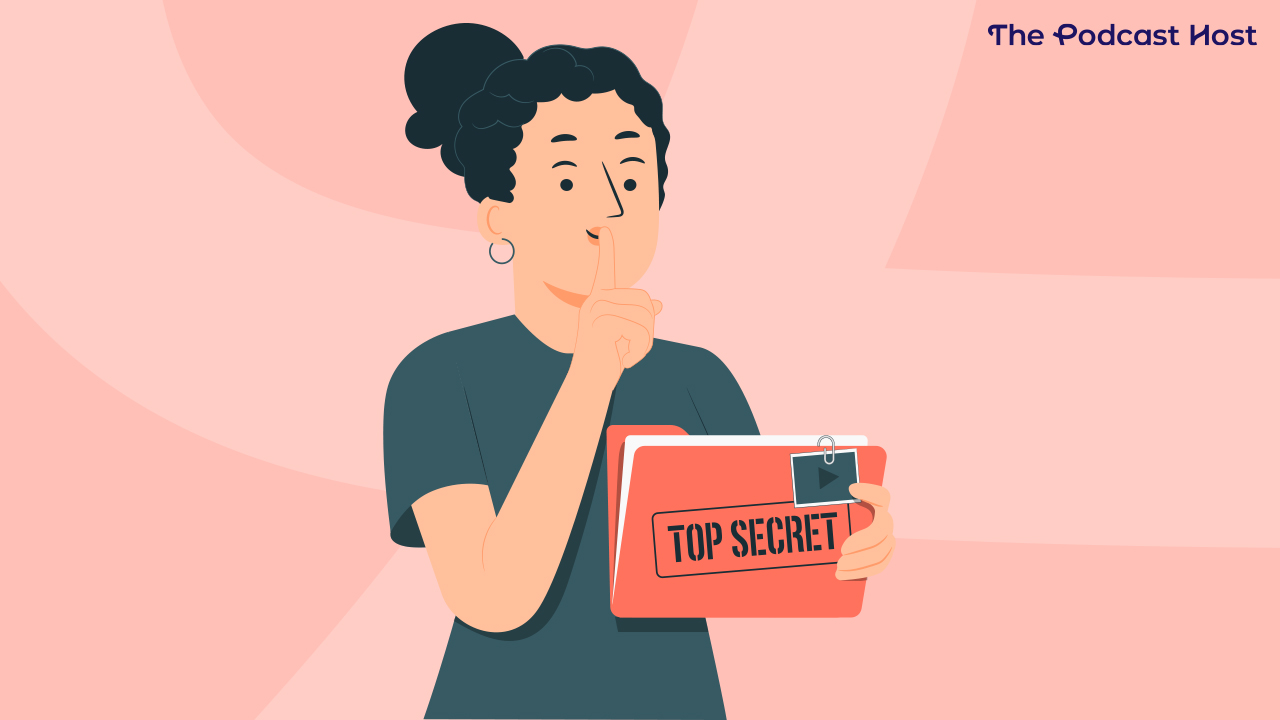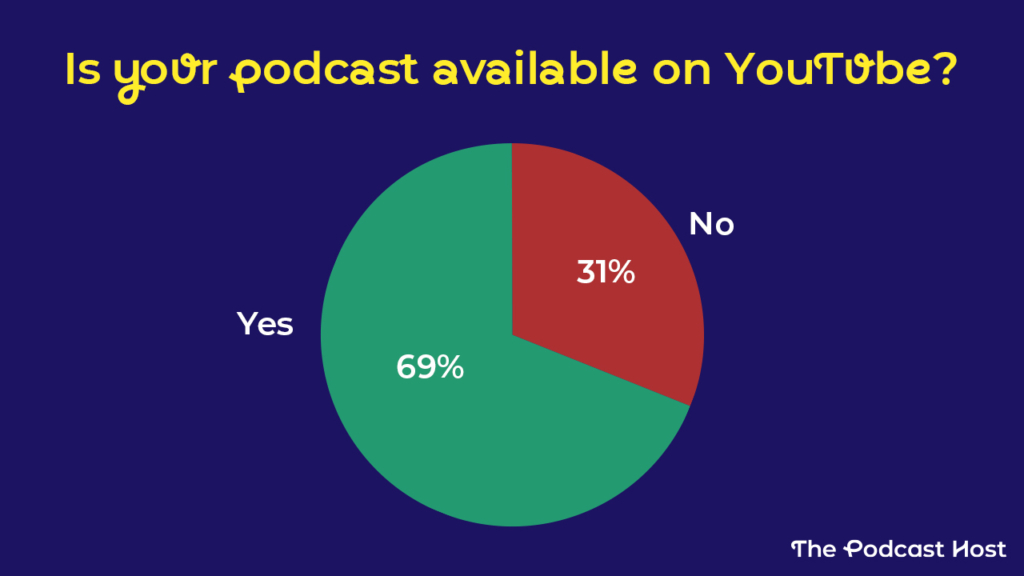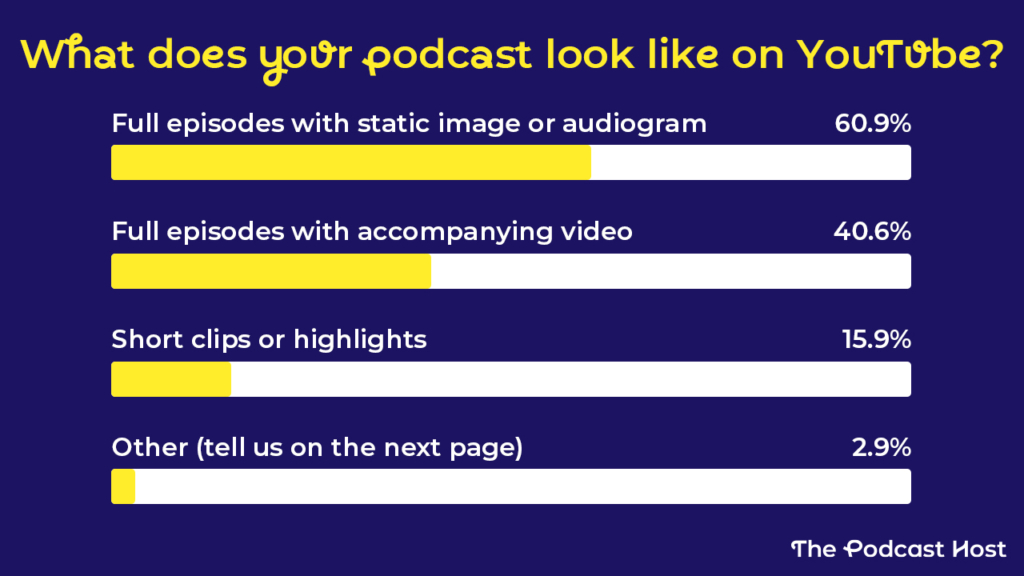The Truth About ‘Video Podcasts’ on YouTube

Our founder, Colin, recently spoke out about how he fears that “video is killing more podcasts right now than anything else is, or anything else ever has.”
And the reason for this? Because podcasters are feeling the pressure to create video even when they don’t have the drive, capacity or means to do so.
All the hype around video has created a situation where podcasters feel we have to do video or we’ll fall behind. That creating video is an absolute requirement for growing a podcast.
We know video is a topic that tends to divide the podcasting community – which makes it even more important that we keep talking about it.
With this in mind, we surveyed podcasters to learn more about how they’re using YouTube (if at all) in their podcast strategy. Our survey sample included readers of the site and newsletter subscribers, who are largely independent podcasters, with a mixture of aspiring, early-stage, and established creators.
The results were pretty interesting, to say the least. Here’s what the survey told us, what the results mean, and why you absolutely shouldn’t cave to the video pressure if it’s not something you actually want to do with your show.
Podcasts on YouTube: The Real Picture
We surveyed 100+ independent podcasters about how they use YouTube. The data revealed that although 69% of podcasters have made their podcasts available on YouTube, less than half (41%) are actually video versions of full episodes.

The majority of these podcasts (61%) are uploaded to YouTube as audio with a static image or audiogram—not video. This is hardly surprising, as YouTube actively encourages this technique. That’s exactly how YouTube’s new RSS feed works: Submit your RSS on the platform, and it will automatically post the audio and pull your podcast artwork to post as an accompanying static image.
How Podcasters Are Really Using YouTube
So if only 41% of podcasters on YouTube are publishing full video episodes of their podcasts, what about the other 59%?

- Static images with audio – 61% of the podcasters we surveyed said they were using something along the lines of “Static logo with audio” or “logo with name of episode and audiogram.”
- Video animations – Some podcasters indicated that they mix in animation with static images: “We have an intro that includes a short animation followed by a series of static images.”
- YouTube shorts – YouTube Shorts are videos of under 60 seconds. These are essentially “headliner promos which appear in YouTube shorts.” In other words, highlights used to promote your podcast on the platform.
- Combination of video and audio – One podcaster told us: “When I have a guest, I include the video on YouTube. When I am solo, it is a static image with audio.” In another survey last year, 16% of podcasters we spoke to told us they use video platforms to interview remote guests, and publish these as videos once they’re done editing. This makes a lot of sense, as they’ll be creating video naturally as part of the podcast workflow, meaning this option requires no extra graft.
Clearly, podcasters are getting creative to take advantage of the growth and visitability potential that YouTube offers without having to create full video episodes.
What the YouTube Data Tells Us About ‘Video Podcasts’
The main takeaway from this survey is that the rise in number of podcasts on YouTube – and the rise in listeners using YouTube to consume podcast content – is not the same thing as a rise in ‘video podcasts’. These scenarios shouldn’t be conflated.
There’s no arguing that YouTube is an excellent platform for listening to podcasts (especially where discoverability is concerned), and it’s becoming more popular every day. But that’s not necessarily indicative of a need for more video—it’s indicative of more people using YouTube.
YouTube is now the second largest search engine after Google (and is owned by Google, which is why videos are always prioritized in Google searches). Because so many people are already on YouTube, they’re using it more for podcast listening—it’s as simple as that.
Tom Webster from Sounds Profitable told us a recent study they ran indicated that;
“video podcast “watchers” also listen to the same shows on audio – they choose based on environment and context – and thinking of them as different humans is shortsighted.”
Tom Webster @ Sounds Profitable
Another study by Signal Hill from 2022 showed that, although 18-34 year olds are ‘watching’ podcasts on YouTube, a large proportion of them (29%) are minimising the video into the background and actually just listening.
So the fact someone listens to a podcast on YouTube does not mean you need to be making video content in order to serve them. It’s more about making your podcast content available on as many platforms as possible so your audience can listen wherever they want.
Why You Shouldn’t Cave to Video Podcast Pressure
Clearly, the hype around video in podcasting isn’t as black and white as many make out. While making video versions of your podcast might absolutely be the right call for your podcast, it’s not for everyone. And most importantly, don’t let video get in the way of you creating great content.
Here are just a few reasons why podcasters shouldn’t bow to the video podcast pressure:
Trust the data, not the hype
Allegra (who manages our popular IndiePod community) submitted a really interesting comment to an opinion roundup we published recently:
“Podcasters don’t usually just jump on trends. And if they do, it’s normally heavily based on data. […] I’m really surprised at the number of people who seem to have jumped on the video trend, and I’m fascinated to see if six months from now, nobody cares about video anymore, because we will have moved on to something different.”
Allegra Sinclair, Community Manager @ IndiePod
And right now, the data is telling us that YouTube is becoming a popular platform for consuming podcast content. Based on that data, it makes sense to make your podcast available on YouTube in some capacity to capitalise on that growth. But that’s about it.
Video undermines a lot of what works so well with audio
There’s so much data out there that shows that the audio formula works. Like, really works. Studies have shown that people trust podcasts more than mainstream news channels, they engage with podcast ads more than ads they see on television. The parasocial relationships listeners build with hosts are even shown to make people feel less lonely.
It’s a winning formula that loses much of its power if transferred to video. Stick to what you know is working—if it ain’t broke, don’t fix it.
Video is hard, and can slow you down
To refer back to Colin’s comment, there’s really no doubt about it: video hype is preventing great podcast content from being made.
There are people who aren’t starting their podcasts because they think they have to do video and they don’t want to, or they don’t have the tools to do it. There are podcasters giving up because they don’t have the capacity to do video, and they think this means they’ll be left behind.
Running a successful podcast is already hard in the sense you have a lot to think about (content ideas, consistency, growth…) and video makes it harder.
Video won’t make you go viral
For all the extra work involved in recording and editing video episodes, there’s not a massive amount of return. You won’t suddenly see your engagement stats go through the roof just because you’re now ‘doing video’.
Yes, thousands of people want to watch Joe Rogan and TikTok stars speak into a mic, but that’s because they are video content creators. This is where they started and where they’re likely to stay. And let’s face it, it’s unlikely your audience will need to see you on video to enjoy your podcast (as much as I’m sure the camera loves you).
Video creates barriers
My colleague Matthew wrote an interesting piece on how podcasting has enough barriers as it is for beginners. And Lindsay also wrote about how video is less inclusive and exacerbates the gender divide in podcasting.
But video also requires better technology, a studio environment, the drive to look your best on camera. Essentially, all the things that we’re grateful don’t apply to audio and that make the barrier to entry lower and make the medium more inclusive.
Embrace Audio AND YouTube
The good news is that podcasters can have the best of both worlds without fully diving into the world of video creation. Yes, it’s a no-brainer to make your show available and discoverable on YouTube, but you don’t even need to own a camera to make that happen.
Content creation is a journey, not a destination, and you might soon arrive at the point where you have the confidence, extra time, and bigger budget to go all in on video. If you do, then brilliant. But if you never get to that stage (or flat-out never want to), then your podcast will be no less for it. So please, never let this hold you back. Or worse still, prevent you from starting at all.

